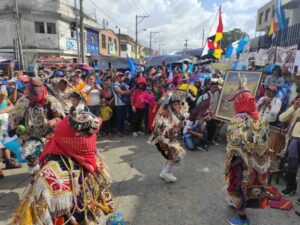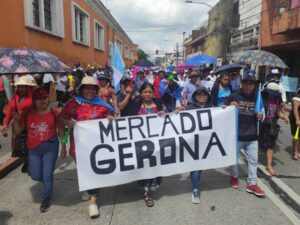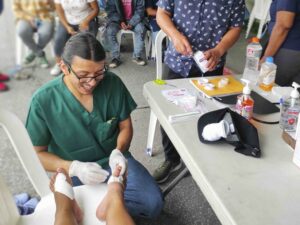
Maya Kaqchikel dancers perform at the protest outside the public prosecutors’ office after walking for four days from the Chimaltenango department to Guatemala City. Photo: Sandra Cuffe.
The kitchen tent was bustling with activity as volunteers prepared tortillas, scrambled eggs, doled out portions of beans and cheese, and poured coffee. It was just before eight in the morning at the protest outside the public prosecutors’ office in Guatemala City, where a dedicated crew has been serving Indigenous leaders and other demonstrators around the clock for more than two weeks straight.
“We have been sleeping here,” said Juana Chávez, gesturing to a little patch of road under the canopy, between piles of equipment and shelves stacked with food supplies. A Maya K’iche member of Oxlajuj Ajpop, an organization dedicated to Mayan spirituality and sacred sites, Chávez has been one of the core kitchen volunteers since day one. “We are here in the resistance,” she told Ojalá proudly of the crew of women and men, young and old, Indigenous and not.
The Guatemala City protest is part of an Indigenous-led national shutdown now in its third week, with ongoing highway and road blockades around the country, and the threat of an imminent crackdown. People are demanding the resignations of the attorney general and other judicial system operators who are behind the efforts to subvert electoral democracy.
Outrage against ‘the pact of the corrupt’
Bernardo Arévalo, a social-democrat congressman and son of the country’s first democratically elected president, won the presidential run-off election on August 20. Since he qualified for the run-off in June, prosecutors have periodically raided election tribunal offices, seized original vote tally sheets, targeted election magistrates, sought to cancel Arévalo’s Semilla party, and continued investigations into various aspects of the electoral process. There is widespread concern that the ultimate aim of the efforts, condemned by everyone from local community associations to the UN Secretary-General, is to prevent Arévalo from taking office in January.
“They want to carry out a technical coup d’état,” said Mynor Say, a Maya K’iche authority from the village of Vázquez in Totonicapán, during a march in Guatemala City. “We are seeing that democracy is being undermined in Guatemala.”
Indigenous authorities—elected autonomously by their communities—from Totonicapán and around the country called the shutdown, and their representatives have maintained a permanent presence in the capital. The mass actions began as dawn broke on October 2, when thousands of people began gathering along the Pan-American and other highways in Guatemala. The shutdown is categorically non-partisan; people are defending democracy, not Arévalo or his party.

Thousands of vendors from markets all over Guatemala City march to the public prosecutors’ office in support of the demands of Indigenous authorities. Photo: Sandra Cuffe.
The number of highway and road blockades has constantly fluctuated up and down, ranging from a dozen to more than 150, peaking on October 9. Since then, many have let up, some periodically let traffic through, and a few have been evicted by police. Groups of armed men have also intimidated or attacked several blockade actions, in a few cases opening fire and injuring demonstrators. A protester, Francisco Gonzalo Velásquez, was killed on October 16 when gunmen attacked a blockade in the municipality of Malacatán, near the Mexican border.
Interior Minister Napoleón Barrientos resigned the evening of October 16, citing “the complexity of the current situation in which the country finds itself” in his resignation letter. In charge of the national police force, he had been under pressure to crack down on the protests. Prosecutors filed a court motion earlier that day seeking to force his removal for failing to do so.
On October 18, the Constitutional Court ordered police to take action and “enable full access” to all locations of the public prosecutors’ office within six hours. The court also ordered the military to assist if necessary. The protest outside the Guatemala City headquarters is not obstructing employee access, but protesters expect a crackdown.
The convoluted latest chapter in a long-simmering crisis did not come out of nowhere. When Arévalo unexpectedly made it to the run-off and then won, “we saw this coming,” said Angelina Aspuac, coordinator of the National Movement of Maya Weavers. “State institutions today are coopted,” she told Ojalá at the protest outside the public prosecutors’ office.
After a few years of groundbreaking criminal cases that saw former heads of state stand trial for genocide and corruption, a backlash campaign began around 2017 and has not stopped since. The government shuttered a UN-backed anti-impunity commission. Dozens of judges and prosecutors facing criminalization and threats were forced into exile. An informal multi-partisan ruling alliance commonly known as the “pact of the corrupt” stacked the Constitutional Court, the ultimate check and balance on power. Supreme Court and appeals court magistrates have now been in office four years beyond their five-year terms.
“They see Bernardo Arévalo as a threat because he is a dissident voice in this whole process of corruption,” Aspuac said of the alliance that effectively controls all three branches of government. “Now they want to prevent him from taking office at all costs.”
Joy and hope on the front lines
In spite of the democratic backsliding and attacks against blockades, the actions have also been celebrations of resistance, with music, dancing, art, ceremonies, piñatas, and other activities. Communities have been caravaning and even arriving on foot to support blockades in the highlands and capital, taking turns to keep the actions going strong. Every day, different old US school buses painted in vivid colors are parked behind the public prosecutors’ office.
Around the corner, doctors set up tables and boxes filled with medications and supplies every morning at a makeshift medical aid station, an all-volunteer initiative that got started toward the end of the first week of the protest. Every day, the team provides medical attention to roughly 350 people, among them Indigenous authorities, protesters, neighborhood residents, and anyone else who shows up. Some of the most common ailments they see are respiratory infections, diarrhea, and skin infections, according to Carlos Díaz, one of the volunteer doctors.

At the medical aid tent outside the public prosecutors’ office, doctor Carlos Díaz bandages the feet of a Kaqchikel woman who marched for four days to Guatemala City. Photo: Sandra Cuffe.
“We responded to the call of the Maya authorities to resist,” Díaz told Ojalá, adding that they too will remain until the clamor of the people’s struggle is heard. “Our way of protesting against the government, against corruption, against shortages, is providing health to the people.”
Beyond the stationary protests and support organizing, marches snake through the capital on a near-daily basis. Diverse sectors have been mobilizing, and market tenants and vendors have been especially active. One of their biggest marches involved thousands of people from dozens of markets, filling multiple city blocks. Alicia Portillo, a clothing vendor at the San Martín market, told Ojalá no one can remember there ever having been such a united mass movement across markets in the city.
“We’re showing that democracy really matters to us,” José Pérez, who sells jewelry at the El Tierrero market in another zone of the capital, shouted over the ear-splitting din of plastic noisemakers. Market closures are affecting him and so many others who live day to day, he said, “but it is better to stop work to support the people because we show that everybody united can create change and make a difference.”
The march ended with a show of support for Indigenous authorities at the protest outside the public prosecutors’ office, where —as at other actions around the country— people vow they will remain until the attorney general and others resign. “I don’t think their resignations would resolve the situation, but it would be a step,” said Aspuac. “We don’t have much hope in this state. Nevertheless, we can’t remain silent.”
This article originally appeared on Ojalá, Oct. 18, 2023


Leave a Reply